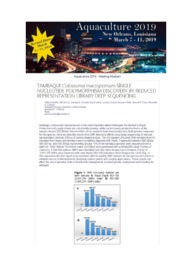Tambaqui (Colossoma macropomum) single nucleotide polymorphism discovery by reduced representation library deep sequencing.
Tambaqui (Colossoma macropomum) single nucleotide polymorphism discovery by reduced representation library deep sequencing.
Autoria: IANELLA, P.; YAMAGISHI, M. E. B.; VARELA, E. S.; VILLELA, L. C. V.; PAIVA, S. R.; CAETANO, A. R.
Resumo: Tambaqui (Colossoma macropomum) is the most important native freshwater fish farmed in Brazil. Production and supply chains are consistently growing, while current yearly production levels of this species exceed 200.000mt. Recent efforts of our research team have produced a draft genome sequence for this species. Here we describe results from SNP discovery efforts using deep sequencing of reduced representation libraries (RRLs) of varying fragment sizes. Ten micrograms of bulked DNA samples from 63 unrelated fish (males and females) were completely digested with HaeIII. Fragments between 400?500bp; 500?650 bp; and 650?850bp representing around 12% of the tambaqui genome were sequenced with a depth of >100x. Nearly 720 million reads (2x150bp) were generated with a HiSeq2000 using TruSeq v3 chemistry, 2.444.604 putative SNPs were identified and their allele frequencies estimated. A total of 2.011.219 SNPs were observed with read depths RD>150 and minor allele frequencies >0.05 (Fig. 1). This represents the first report of an extensive effort to identify SNP markers for this species and will be a valuable source of information for designing marker panels with varying applications. These results can affect the use of genomic tools in broodstock management, assisted genetic evaluations and breeding for tambaqui.
Ano de publicação: 2019
Tipo de publicação: Anais e Proceedings de eventos (considerados no todo)
Unidade: Embrapa Agricultura Digital
Palavras-chave: Bioinformática, Colossoma Macropomum, Peixe, Polimorfismo de nucleotídeo único, Tambaqui
Observações
1 - Por padrão são exibidas publicações dos últimos 20 anos. Para encontrar publicações mais antigas, configure o filtro ano de publicação, colocando o ano a partir do qual você deseja encontrar publicações. O filtro está na coluna da esquerda na busca acima.
2 - Para ler algumas publicações da Embrapa (apenas as que estão em formato ePub), é necessário ter, no celular ou computador, um desses softwares gratuitos. Sistemas Android: Google Play Livros; IOS: iBooks; Windows e Linux: software Calibre.
Acesse outras publicações
Acesse a Base de Dados da Pesquisa Agropecuária (BDPA) para consultar o acervo completo das bibliotecas da Embrapa.

